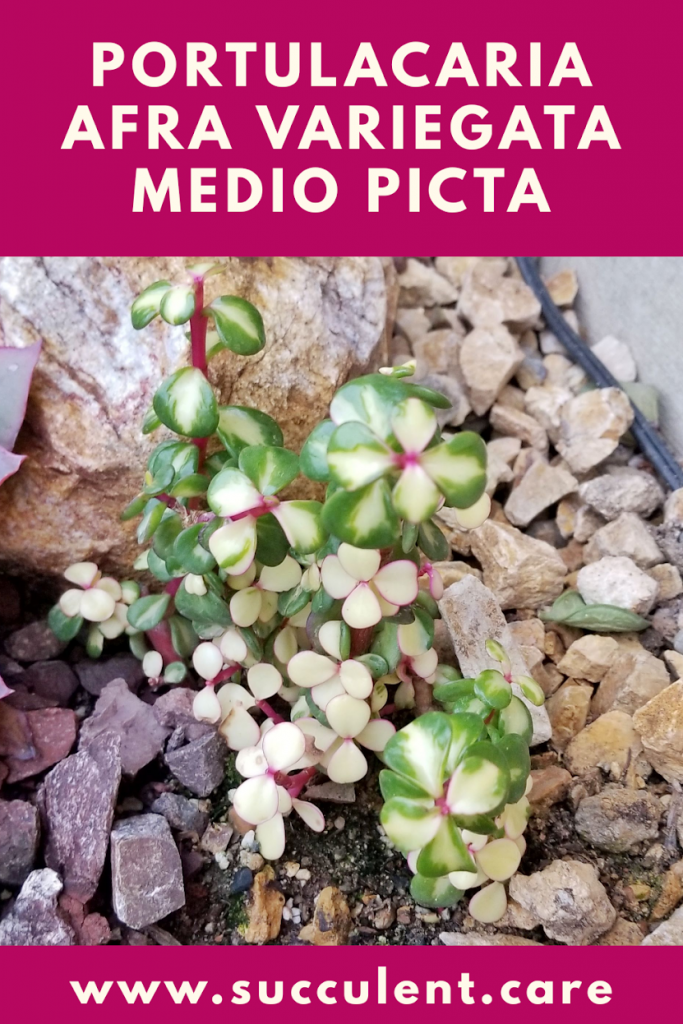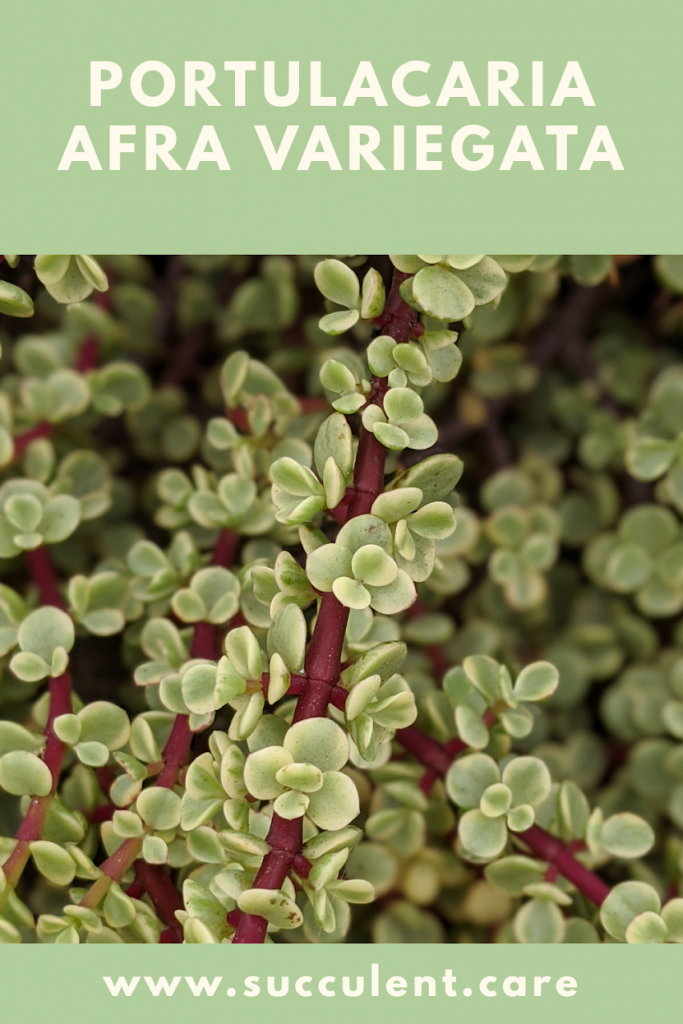Dig in!

Portulacaria afra “Elephant Bush’, also known as elephant bush, porkbush, purslane tree, and spekboom, is a small-leaved succulent plant that is native to South Africa. The plant is known for its reddish stem and green leaves, but there is also a variegated cultivar that is commonly seen in cultivation. They are simple to care for and make easy houseplants for a sunny location. In frost-free regions, they may be used in outdoor landscaping.

Distribution and Habitat
Portulacaria afra “Elephant Bush’ is very widespread in the east of South Africa (as well as Eswatini). In this moist climate, it is relatively rare, and tends to favor dryer rocky outcrops and slopes. It is also found in much denser numbers in the dryer southern Cape.
Here it occurs from the Little Karoo of the Western Cape, eastwards up until the thicket vegetation of the Eastern Cape. Spekboom is found most prolifically in the Albany thickets, a woodland ecoregion, which locally is often called noorsveld, after the high number of succulent Euphorbia species, which are often called noors plants. In these environments, Portulacaria afra “Elephant Bush’ is a source of food for multiple large herbivores, such as the Black rhinoceros and the African elephant. Although it is not the primary food source for these animals, it still makes up a significant portion of their diet.

Cultivation and Uses of Portulacaria afra
Portulacaria afra, commonly known as ‘Elephant Bush’, is a popular succulent shrub that is native to South Africa. It thrives in hot and dry climates and is often grown as a landscape plant in arid regions like Phoenix, Arizona or Southern California.
In its natural habitat, Portulacaria afra grows in dense thickets. The dense growth provides its own natural insulation and allows it to survive frosty winter temperatures that might damage isolated plants. This cold-hardiness, along with its drought tolerance and fire resistance, makes it well suited to hot desert climates. It can endure long periods of hot sun and high temperatures once established. In contrast, the similar-looking jade plant is less tolerant of heat and cold.
Portulacaria afra can be propagated from cuttings, which root very easily in typical potting media. This makes it a great candidate for cultivation as a houseplant or in gardens. It grows as an upright shrub that can reach 6-8 feet in height with attractive small rounded succulent leaves. The arching branches have an interesting twisted shape. If pruned regularly, it can be kept shorter and bushier.
Due to its resilience and unique appearance, Portulacaria afra is valued as a low-maintenance landscape plant for dry, sunny areas or as an unusual houseplant. It’s a great choice if you want an easy but eye-catching succulent to grow.

Ornamental
Portulacaria afra “Elephant Bush’ is popular as a specimen for bonsai and as a hardy xeriscaping plant. Several varieties exist – some bred in cultivation, others naturally occurring:
“Limpopo”: A variety with much larger leaves. It is the natural form from the far north of the species’ range.
“Prostrata”: A low-lying, decumbent form that is frequently used as a ground-cover.
“Aurea”: A compact, upright form with rounded leaves that go bright yellow in the sun.
“Foliis variegatus”: A variegated form.
“Medio-picta”: Variegated with a lighter center.


Key Requirements for Light, Water, and Soil
Like all succulents, Portulacaria afra requires bright, indirect light to thrive. It is best to place your Elephant’s Food in a location that gets plenty of natural light, but avoid direct sun exposure, as this can lead to sunburn and other problems.
When it comes to watering, it is important to remember that succulents are adapted to survive in dry conditions. As a result, they do not require frequent watering and are more likely to suffer from over-watering than from under-watering. To water your Portulacaria afra, allow the soil to dry out completely before watering again. You can check the moisture level of the soil by inserting your finger about an inch into the soil. If it feels dry, it is time to water your succulent.
In terms of soil, it is important to use a well-draining mix that is specifically formulated for succulents. This will help to prevent the roots of your Elephant’s Food from becoming waterlogged, which can lead to root rot and other problems.

Care and Maintenance
When it comes to care and maintenance, Portulacaria afra “Elephant Bush’ is a relatively low-maintenance plant. It prefers a sunny location, but can tolerate some shade. The plant is drought-tolerant and can survive long periods without water, but it should be watered regularly during the growing season.
Fertilization is not necessary, but a balanced fertilizer can be used during the growing season to promote growth. Pruning and shaping can be done to control the size and shape of the plant, but be careful not to over-prune as it may damage the plant. Pest and disease control is not usually necessary, but mealybugs and scale insects can be a problem in some cases.
Propagating Portulacaria Afra
One of the great things about Portulacaria afra is that it is easy to propagate from cuttings. To propagate your Portulacaria afra, follow these simple steps:
- Take a cutting from a healthy, established plant.
- Allow the cutting to callous over for a few days. This can be done by placing the cutting in a dry, shaded location and allowing the cut end to heal over.
- Once the cutting has calloused over, it is ready to be planted. Fill a small pot with a well-draining soil mix and moisten the soil lightly.
- Plant the cutting in the soil, making sure that the cut end is buried at least an inch deep.
- Water the cutting sparingly and provide bright, indirect light. Keep the soil moist, but not soggy, and avoid direct sun exposure.
- With proper care, your cutting should take root and grow into a healthy, new Portulacaria afra.


Troubleshooting Common Problems
Like any plant, Portulacaria afra is susceptible to a range of problems, including pests, diseases, and environmental stress. Some common issues to watch out for include:
- Yellowing leaves: This can be a sign of over-watering or under-watering. Make sure you are watering your Elephant’s Food only when the soil is completely dry and that you are using a well-draining soil mix.
- Brown, crispy leaves: This can be a sign of sunburn or overexposure to direct sunlight. Make sure you are providing your Portulacaria afra with bright, indirect light and avoid placing it in direct sun.
- Pests: Succulents are relatively resistant to pests, but they can still be prone to infestations of aphids, mealybugs, and other insects. To prevent pests, it is important to keep your Elephant’s Food clean and free of debris, and to check it regularly for any signs of infestation. If you do notice pests, you can try using a gentle, organic insecticide to get rid of them.
- Diseases: Portulacaria afra can be prone to fungal diseases such as root rot, as well as bacterial infections. To prevent these diseases, it is important to water your Elephant’s Food sparingly and to use a well-draining soil mix. If you do notice any signs of disease, it is important to act quickly to isolate the affected plant and to treat it with a suitable fungicide or antibiotic
- Environmental stress: Succulents can be sensitive to changes in their environment, such as temperature fluctuations or changes in light levels. To prevent stress, it is important to provide your Portulacaria afra with consistent care and to avoid making sudden changes to its environment.

In addition to the key requirements for light, water, and soil, there are a few other things you can do to keep your Portulacaria afra healthy and happy. Here are a few tips to consider:
- Fertilize sparingly: Succulents do not require much in the way of fertilization, and too much fertilizer can actually do more harm than good. If you do choose to fertilize your Portulacaria afra, use a balanced, organic fertilizer and follow the instructions on the label carefully.
- Repot as needed: As your Portulacaria afra grows, it may eventually outgrow its pot. When this happens, you will need to repot it into a larger container. Choose a pot that is only slightly larger than the current pot and use a well-draining soil mix.
- Prune as needed: Over time, your Portulacaria afra may start to look a bit overgrown. If this happens, you can prune off any dead or damaged leaves to keep your plant looking neat and tidy.

Medicinal
Portulacaria afra “Elephant Bush’ is one of the many plants used as a traditional treatment for skin conditions used by people in rural areas that do not have easy access to more modern medicine.
Food source
In Southern Africa it is commonly eaten, usually as one component of a salad or a soup. It should not be confused with the jade plant, which is mildly toxic. Portulacaria afra “Elephant Bush’ is also used to feed livestock during periods of drought due to its succulent nature. Most commonly used for cattle and goats, these plants also act as a supplemental source of water on top of their nutritional benefits for livestock.

Carbon sequestration and ecological impact
Portulacaria afra “Elephant Bush’ is capable of either C3 or CAM carbon fixation, depending on factors such as the season and the age of the plant. This property has led to Portulacaria afra “Elephant Bush’ being used in reforestation projects and habitat restoration. In fact, Portulacaria afra “Elephant Bush’ is one of the most effective carbon sequestration plants in the world and has the potential to play a significant role in mitigating the effects of climate change.

Conclusion
Overall, Portulacaria afra “Elephant Bush’ is a versatile and resilient plant that is easy to care for and can be used for a variety of purposes. Whether you’re looking to add some greenery to your home, create a unique bonsai specimen, or contribute to carbon sequestration and habitat restoration, Portulacaria afra “Elephant Bush’ is an excellent choice. With its beautiful leaves, hardy nature, and many potential uses, it’s no wonder why Portulacaria afra “Elephant Bush’ is becoming an increasingly popular plant among gardeners and plant enthusiasts alike.

Where to Buy Succulents Online


